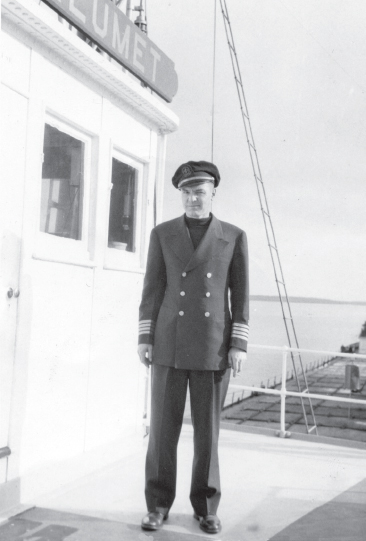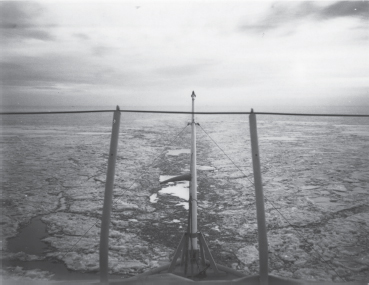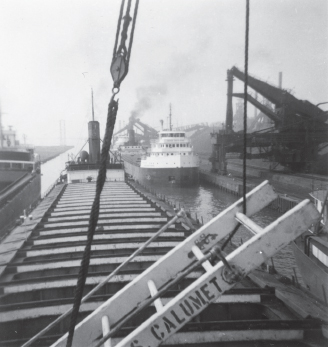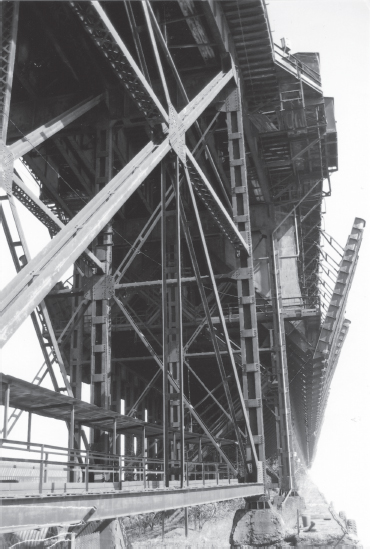Ship Captain's Daughter
Read Ship Captain's Daughter Online
Authors: Ann Michler Lewis


Ship Captain's Daughter
Ship Captain's Daughter

Growing Up on the Great Lakes
Ann M. Lewis
WISCONSIN HISTORICAL SOCIETY PRESS
Published by the Wisconsin Historical Society Press
Publishers since 1855
© 2015 by the State Historical Society of Wisconsin
E-book edition 2015
For permission to reuse material from
Ship Captain's Daughter
(ISBN 978-0-87020-730-3; e-book ISBN 978-0-87020-731-0), please access
www.copyright.com
or contact the Copyright Clearance Center, Inc. (CCC), 222 Rosewood Drive, Danvers, MA 01923, 978-750-8400. CCC is a not-for-profit organization that provides licenses and registration for a variety of users.
All photos are from the author's family collection unless otherwise noted. The cover photo shows the author's daughter, Amy Michler Lewis (married name Hunter), at age four, as she watches her grandfather's ship, the SS
Herbert C. Jackson
, enter the Duluth canal.
Cover design by Shawn Biner, Biner Design
Typesetting by Integrated Composition Systems, Spokane, Washington
19 18 17 16 15Â Â Â Â Â Â Â 1 2 3 4 5
E-book Cataloging in Publication Data
Lewis, Ann M.
    Ship captain's daughter : growing up on the Great Lakes / Ann M. Lewis. â 1st edition. 1 online resource.
     Description based on print version record and CIP data provided by publisher; resource not viewed.
     ISBN 978-0-87020-731-0 (e-book) â ISBN 978-0-87020-730-3 (print) 1. Lewis, Ann M.âChildhood and youth. 2. Ship captainsâMinnesotaâDuluthâBiography. 3. Ship captainsâFamily relationshipsâAnecdotes. 4. Seafaring lifeâGreat Lakes (North America)âAnecdotes. 5. GirlsâMinnesotaâDuluthâBiography. 6. Great Lakes Region (North America)âBiography. 7. Duluth (Minn.)âSocial life and customsâ20th century. 8. Duluth (Minn.)âBiography. I. Title. II. Title: Growing up on the Great Lakes.
VK139
386'.244092âdc23
[B]
2015020135
To my parents Willis C. Michler and Dagmar A. Michler
my husband Herb
my children Amy and Lee
my son-in-law Jay and daughter-in-law Tiffany
my grandchildren Chloe, Sophie, and Herbie
and to all the people of the lake
Some went down to the sea in ships, doing business on the mighty waters.
âP
SALM 107
Contents

My father, Captain Willis C. Michler, stands next to the pilothouse of the SS
Calumet
, his second command. The four stripes on his sleeve designate his status as ship's master.
The ship comes in, the ship goes out. As the daughter of a Great Lakes ship captain, I grew up to the rhythm of the transport of iron ore. From the arrival of the shipping orders in March to “lay up” in December, from climbing the ship's ladder weekly to see my father while he was in port to watching his ship disappear again over the horizon line, my life was dominated by the excitement, the loneliness, the drama, and the lure of the shipping industry and the water.
My hometown of Duluth, Minnesota, is located at the western tip of Lake Superior. The water has always been the life of Duluth and its sister city, Superior, Wisconsin, where my father grew up. When iron ore was discovered in northern Minnesota and Wisconsin in the late 1800s, the Twin Ports, with their natural harbor, made it possible for giant cargo ships to carry ore from the mines in the north down through the Soo Locks to the steel mills on the lower lakes in the east. For generations, many local men have worked as shipbuilders, dockworkers, chandlers, uniform manufacturers, stevedores, and bridge tenders.
And then there are those men who have worked on the lake. My father, Willis Carl Michler, was one of them. He sailed the Great Lakes for forty-seven years and was a captain of thirteen different ships for twenty-one of those years. Drawn to the water and the big ships as a young man, he followed a dream of becoming a Great Lakes ship captain, and he and my mother and I lived it out together, in all its rich and varied and demanding dimensions.
My father's sailing career spanned the height of Great Lakes iron ore shipping, the lows of the Great Depression, World War II
(during which time the sailors served the country as members of the Merchant Marine), the opening of the St. Lawrence Seaway, the advent of radar, and the development of the taconite trade. He sailed before the invention of computers, GPS, cell phones, email, and Skypeâand before sailors could apply for summer vacations. When I was growing up, we relied on letters Dad mailed from ports throughout the Great Lakes, calls from pay phones, and rare ship-to-shore calls. Today the ships that traverse the Great Lakes can be tracked on the internet. Many are twice the size of the freighters my dad first sailed, though at this writing, my father's last command, the SS
Herbert C. Jackson
, is still sailing, albeit with modern renovations. Instead of raw iron ore, the ships now carry taconite pellets and varied other cargoes such as coal and grain. Yet for those who continue to work on the ships, some things remain unchangedâthe urgency to deliver cargo quickly, the challenges of weather, time away from family, and the powerful call to a life on the water.

My dad's ship rests at the dock in Ashland, Wisconsin, a seventy-mile drive from the Twin Ports of Duluth-Superior. The dock was built in 1915 to load ships with iron ore mined on the Gogebic Range of eastern Wisconsin and western Michigan.
My father was the first in his family to have a career on the water. Historically, his people were people of the land. Settling in the Fond du Lac area of southern Wisconsin from the agricultural heartland of Germany, they were courageous, industrious, disciplined, and religious. Some remained farmers, while others became blacksmiths. Two family members founded the Michler Company in Fond du Lac, crafting huge sleighs for use in Alaska and one for the Antarctic explorer Admiral Richard Byrd. One of them ran for mayor and helped found the family church. And one of them, my grandfather, left his people to become a conductor for the Soo Line Railroad Company in the northern Wisconsin port town of Superior, on the shores of the world's largest freshwater lake.
At the age of sixteen, at the urging of
his
father and with the tools of his heritage plus his own romantic spirit, my father sailed out to sea. Ultimately, he became a Great Lakes ship captain.
From time to time, people have asked me what this life was likeâwhat my father was like, what my mother's life was like, and what it was like to be the ship captain's daughter. The stories preserved in this book are my attempt to capture that lifestyleâthe cycles of waiting and bursts of excitement, the vital connection to the lake itselfâexperienced by Great Lakes shipping families like my own.
We were people of the lake. When Lake Superior started to thaw, we started to wait. Most people in Duluth welcomed spring. For our family, it was the beginning of the end, not only of winter, but also of our land time together. When the days grew longer and the ice on Lake Superior began to break up, Dad's shipping orders were soon to come. Every day they didn't was a relief. But sooner or later, inevitably, there they would be, jutting out of the mailbox in the long envelope marked The Interlake Steamship Company.
The house grew quiet, but the tempo of Dad's preparations for departure picked up. So much to do before leaving for the new sailing season: fix that leaky faucet at Grandma's, pick up the new glasses, go to the bank, finish up at the dentist, drain the gas out of the snowblower, and get the lawn mower ready for Mom. Finally, Dad went up to the attic and dragged down the big canvas duffel bag with his name stenciled on it, and the little black bag containing the tools of his tradeâstar chart, quadrant, compass, slide rule. Then he started packing again.
Anticipation grew daily. Calls started coming in from the other sailors in the fleet: “What cook did you get?” “Who is your chief engineer?” Most importantly, “Who is your captain, and what's the name of your ship? Same as last year, or did you âmove up'?” (Salaries were related to the size of the ship.)

In late March, my dad's ship follows the ice cutter's path from the ports of Duluth and Superior out to the open lake.
No more help for me with math homework. No more listening to Dad play the piano into the night. Mother always wanted to have friends over for dinner one last time, but there was no more time. All of that was over. From now until the lake froze over again, we were back on “sailing time.” From March until December, we would live our family life in the spaces that we could find in between the loading, unloading, and shipping of ore.
Some ships laid up for the winter across the bay in Superior at Fraser Shipyards. Dad's ships, however, always laid up in the lower lakes “down below” the Soo Locks at dry docks in Chicago, Ashtabula, Cleveland, or Toledo. In later years, the sailors flew to and from their ships to begin and end the season. When I was young, however, Dad always took the train. Even when life became more informal, he always wore his best suit, tie, and hat to mark this important occasion.

Dad prepares to leave for the old Milwaukee Road depot from my aunt's house in St. Paul, Minnesota, after a going-away dinner.
Once his ship was fitted out and had set sail, the familiar ritual of calculating his weekly arrival to our area began. The
Duluth News Tribune
posted the times that the ships passed through the Soo Locks. About twenty-six hours after locking up, he would arrive in the Twin Ports. If he went through the locks at six on a Tuesday morning, he would be due in at about eight on Wednesday morning, which meant Mom would miss her ten a.m. church circle that week. If he left at one on Wednesday afternoon to go back down, he would be at the Soo at three p.m. on Thursday, in port at ten p.m. on Friday, unloaded by eight a.m. on Saturday, back up bound through the Soo by four p.m. on Sunday, and at a dock near us again at six a.m. on Monday. Now the school
conference for Monday at nine a.m. might have to be canceled, but then again, there just might be a chance that Dad could get off the ship to come with us and meet the teacher, if the weather didn't delay him, or if someone didn't decide to quit and have to be officially terminated and paid off. On the day of my eighth-grade graduation, I remember we got lucky. Dad got in at seven a.m. and was able to get off right away. He had to be back by noon, but he got to see my new dress, hear my piano piece, and help Mom and me pick lilacs in the backyard for the punch table.
When he came to the Twin Ports, he entered the harbor through either the Duluth or Superior entry. The Duluth entry was the best, with its grand and picturesque Aerial Bridge. Especially when I was a child, I used to love to go down to the pier and watch his ship come in. Ideally, we would be there much earlierâin time to watch him break the horizon line. For a long time the boat seemed to barely move. After about a half hour, however, it began growing in size, approaching slowly but steadily, and finally, it came in fast.
“Get ready,” Mom would say. “Here he comes.” The tourists at the pier started runningâsome out to the lighthouse to watch the great ship enter the canalâwhile others sat right on the breakwater. Our favorite place was on the walkway by the marine museum. We watched proudly as the huge ship glided down the canal to tower above us. “Look up,” Mom would say, and there would be Dad. He'd lift up the big black bullhorn with both hands and in a booming voice yell out, “Ahoy, mates! Forty minutes to the dock.” And I'd yell back, “Ahoy, Papa!”
Whether in Duluth or Superior, the docks were all alike. We parked our car by the gatehouse, showed our passes to the guard, and picked our way along the rocky dirt road leading to the stairway that went down to the water. The docks were built to load on both sides, so there was a walkway through the middle. Ore trains rolling out to the ships rumbled on the tracks overhead. Their
brakes screeched when they stopped, scaring the pigeons from their perches on the rafters above us. Even though shafts of light broke in from the outside, it was still dark in there, like in a dimly lit tunnel.

Dad's ship, locking up from the lower lakes to the level of Lake Superior, at the Soo Locks, through which all ships traversing the lakes must pass
On either side of the walkway, there were surge holes. Dirty water slurped over the edges, splashing over our shoes and getting the cement wet. Way down at the end, we sometimes spotted a sailor who had just gotten off his ship to come ashore. It was like looking through the wrong end of the binoculars. The tiny figure got closer and closer, and bigger and bigger, until one of us had to step aside to let the other pass. Sometimes we could smell his aftershave!
Even if it wasn't raining, something always dripped, and there were always loud noises: spouts grinding up and down, whistles, and people yelling orders. If the ore had gotten wet in the open
train cars, it wouldn't run into the hold. On the catwalks, men rhythmically pounded the chutes with long steel rods to break the ore loose.
Kaboom-oom-oom.
The sound echoed in waves off the steel girders.

The eighty-foot-high Ashland, Wisconsin, dock with train cars and dock-workers visible on the top. It was torn down beginning in 2012.
When I got scared, Mom took my hand and we began to march and sing: “Be kind to your fine feathered friends, da da da da da da da da ⦔ Then, through the spaces between the columns, we began to see the ship: first the steering pole, then the forward anchor, then the pilothouse, then the winches, the hatches, and the ladder. Finally we heard my dad yelling, “Hey! Here come my girls!”
To get aboard ship to see Dad, we had to climb the ladder. When I was young, my dad carried me up. He held me in the curve of his left arm, and with his right hand he grabbed and let go, grabbed and let go, lurching from rung to rung as we went up. At the top, he turned and let go of the ladder, jumping onto the
landing and then down onto the deck. When I was older, I climbed the ladder by myself, pretending I was brave. My father bragged about it, but he always stood nervously at the iron platform that hung over the side of the ship reaching out to “catch me” at the top. When I gave him my left hand, he pulled it toward him, quickly taking my right hand as I stepped onto the iron grate.

The ladder we used for boarding the SS
Calumet
is in position for storage, with another ship visible in the background waiting to unload with Huletts (machine-operated buckets).
Sometimes I still dream about it.
If there was a wind, the cables would whine and stretch, letting the ship drift out a little, leaving a foot or two of open water between the ship and the dock. When I looked down to put my foot on the landing, I could see the open space. The ore drippings
made the water rusty brown. If I fell, there would be no way to save me. I was always relieved to make it up, but during the whole time I was aboard I worried about getting back down.

